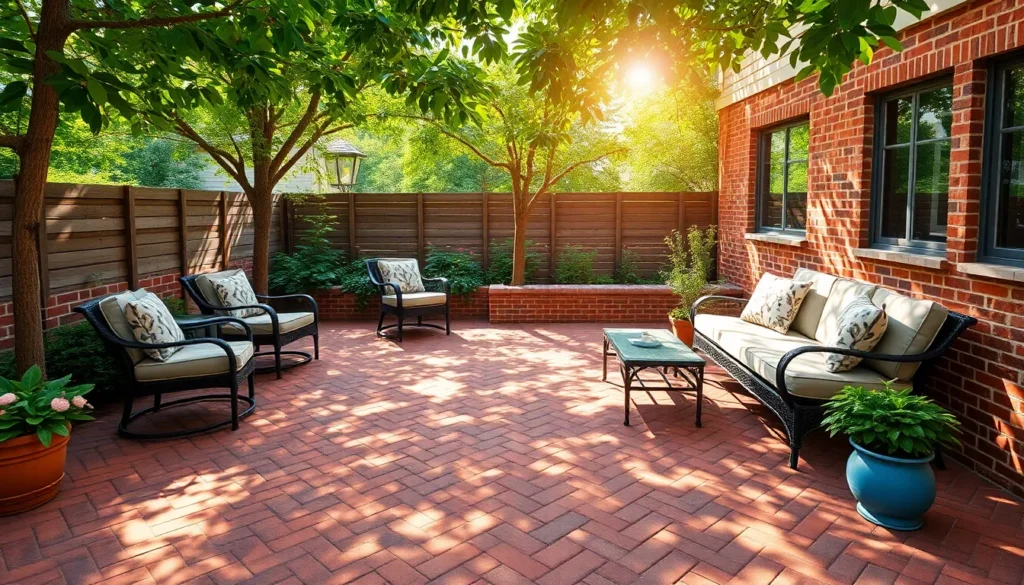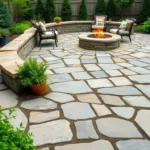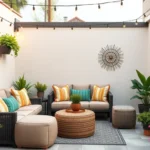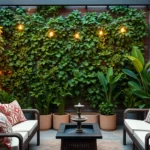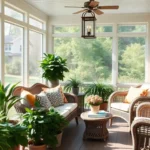We’ve all dreamed of that perfect outdoor space where we can unwind after long days and entertain friends on warm summer evenings. Red brick patios offer a timeless charm that transforms any backyard into an elegant retreat while adding substantial value to your home.
Red brick’s natural beauty and durability make it an ideal choice for outdoor living spaces. Whether you’re drawn to classic herringbone patterns or modern geometric designs, brick patios provide endless possibilities for creating your ideal outdoor sanctuary. The warm terracotta tones complement virtually any industry design and architectural style.
From intimate bistro-style corners to expansive entertainment areas, we’ll explore stunning red brick patio ideas that’ll inspire your next outdoor project. You’ll discover creative layout patterns, design combinations, and practical tips that’ll help you create a space that’s both beautiful and functional for years to come.
Classic Herringbone Red Brick Patio Design
Classic herringbone patterns transform ordinary red brick patios into sophisticated outdoor spaces that capture timeless elegance. This traditional design approach creates visual interest through alternating brick angles that form distinctive zigzag patterns.
Traditional 45-Degree Herringbone Pattern
Traditional 45-degree herringbone arrangements create the most recognizable and elegant red brick patio designs. We recommend this pattern for homeowners who want to achieve a formal, sophisticated outdoor space that complements both traditional and contemporary home styles.
Installation begins with laying bricks at opposing 45-degree angles to form distinctive V-shaped patterns. Each brick connects to its neighbor at a right angle, creating interlocking joints that provide exceptional structural stability for high-traffic areas.
Visual impact increases dramatically when red bricks showcase their natural color variations within the herringbone layout. The alternating angles catch sunlight differently throughout the day, highlighting the rich terracotta tones and subtle texture differences that make each brick unique.
Maintenance requirements remain minimal with this classic pattern since the interlocking design prevents individual bricks from shifting or becoming loose over time. We’ve found that this stability makes 45-degree herringbone patterns ideal for dining areas and entertainment spaces where furniture placement changes frequently.
90-Degree Herringbone Layout
90-degree herringbone layouts offer a more contemporary twist on the classic red brick patio design while maintaining the pattern’s inherent stability and visual appeal. This variation creates a more geometric, structured appearance that works particularly well with modern architectural styles.
Brick placement follows the same interlocking principle as traditional herringbone, but the angles align with the patio’s primary axes rather than diagonal lines. Each rectangular section forms perfect right angles, creating a grid-like effect that emphasizes clean, modern lines.
Design flexibility expands significantly with 90-degree herringbone since the pattern easily accommodates different red brick sizes and shapes. We often combine standard bricks with thin pavers or decorative border elements to create custom patterns that enhance the overall patio design.
Installation speed increases with this layout since the straight-line alignment requires less precise cutting and fitting around curved edges or irregular spaces. The pattern also works exceptionally well for large patio areas where the geometric repetition creates a cohesive, organized appearance that doesn’t overwhelm the space.
Running Bond Red Brick Patio Layout
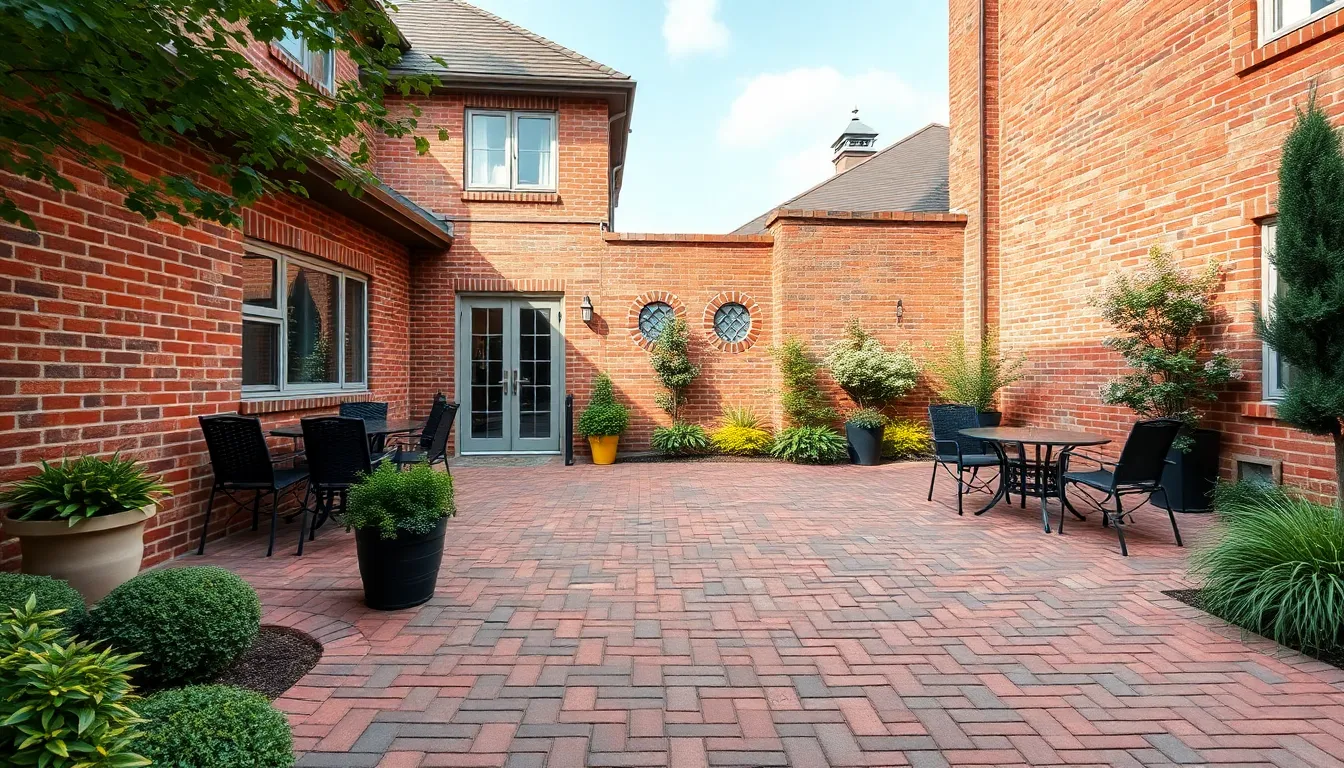
Running bond patterns offer the most straightforward approach to red brick patio design. This classic layout creates a timeless foundation that complements both traditional and modern outdoor spaces.
Stretcher Bond Configuration
Stretcher bond represents the most common brick pattern for residential patios. We position each brick so it’s offset by half the brick length in alternating rows, creating a staggered visual effect that’s both appealing and structurally sound. This configuration showcases only the long faces of the bricks, called stretchers, which align in offset rows throughout the entire patio surface.
The pattern naturally elongates narrow outdoor spaces and makes compact areas appear larger than their actual dimensions. We find this layout particularly effective for rectangular patios where the running lines draw the eye toward focal points like garden beds or outdoor seating areas. The staggered arrangement distributes weight evenly across the surface, making it ideal for high traffic zones where durability matters most.
Installation becomes straightforward with this pattern since we don’t need complex measurements or intricate cutting. The clean lines create a classic red brick appearance that works beautifully with various architectural styles, from colonial homes to contemporary designs. Weather resistance improves with this layout because the offset joints prevent water from creating straight channels through the patio surface.
English Bond Variation
English bond alternates courses of stretchers and headers to create a more textured and traditional appearance. We lay full stretcher rows followed by header rows, where the short ends of bricks face outward, creating distinct visual bands across the patio surface. This alternating pattern adds remarkable structural strength while delivering old industry charm that enhances European style landscaping.
The alternating rows create visual depth and interest that transforms ordinary patios into statement pieces. We recommend this pattern for larger patio areas where the alternating bands can be fully appreciated from multiple viewing angles. The header courses break up the monotony of continuous stretcher rows, adding complexity without overwhelming the overall design.
This configuration works exceptionally well around raised garden beds and fire pit areas where the traditional aesthetic complements natural landscaping elements. The strong structural properties make it suitable for areas that will support heavy outdoor furniture or accommodate frequent entertaining. We often pair this pattern with circular brick accents or basketweave borders to create sophisticated outdoor living spaces that feel both historic and inviting.
Basket Weave Red Brick Patio Pattern
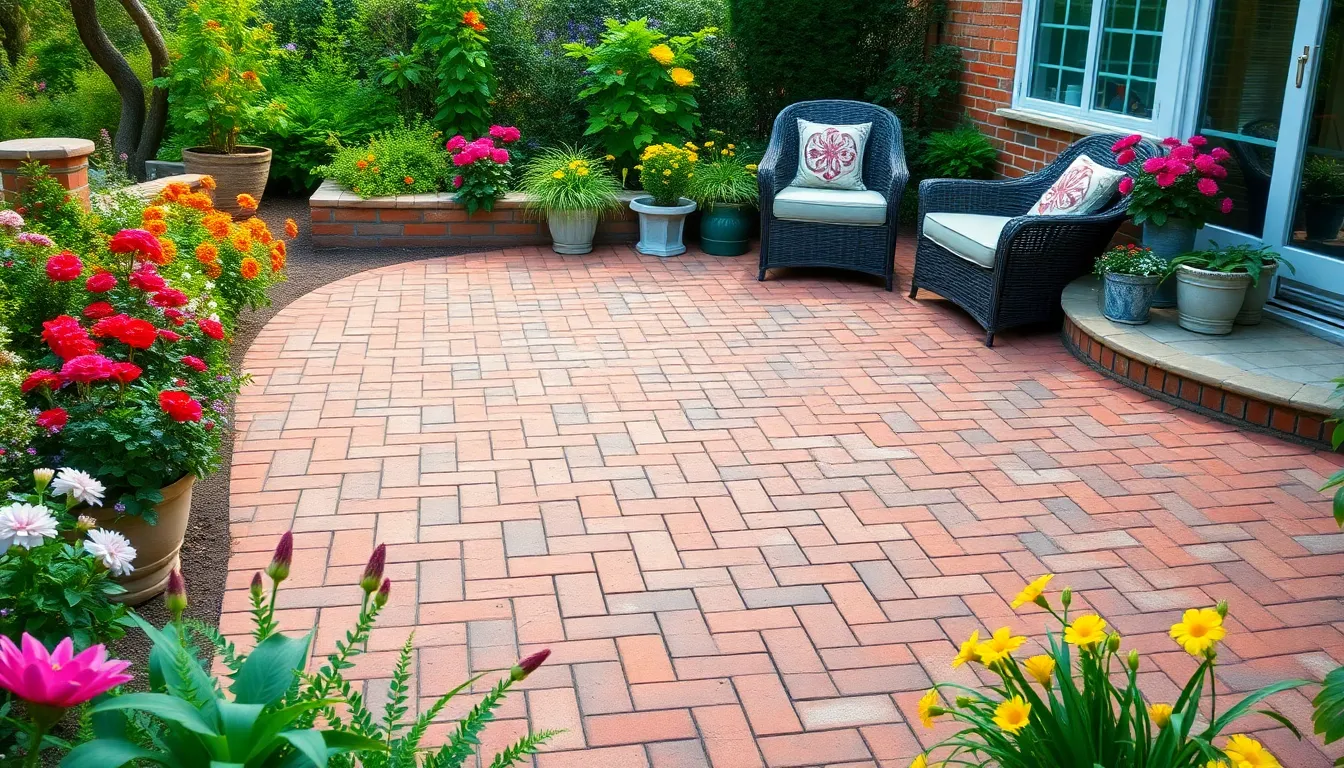
We’ll explore the basket weave pattern, which creates a striking woven appearance that adds texture and visual interest to your outdoor space. This arrangement consists of pairs of bricks laid horizontally and vertically in alternating fashion, resembling a traditional woven basket.
Simple Basket Weave Design
Simple basket weave designs feature clean alternating pairs of bricks that create a uniform grid pattern across your patio surface. This arrangement works exceptionally well for small patios or intimate seating areas where you want to maintain a neat, orderly aesthetic. We recommend this pattern for beginners because it’s straightforward to install while still delivering impressive visual impact.
Pairs of bricks are positioned perpendicular to each other, forming squares that repeat throughout the entire patio area. You’ll find this design particularly effective in corners of your yard where you want to transform a plain space into a charming nook. The uniform nature of simple basket weave creates a calming backdrop that doesn’t compete with outdoor furniture or garden plantings.
Double Basket Weave Style
Double basket weave style uses larger pairs of bricks or doubled units to enhance the texture and boldness of the traditional pattern. This variation creates a more ever-changing look that’s perfect for larger patios needing visual weight and architectural interest. We’ve seen this pattern work beautifully in spacious outdoor areas where the enhanced scale prevents the design from appearing too busy.
Doubled units in the weave pattern create stronger visual blocks that make a bolder statement than the simple version. You can use this approach to define different zones within your patio space, such as dining areas or conversation pits. The increased scale of double basket weave makes it suitable for patios that need to hold their own against large homes or expansive landscapes.
Circular Red Brick Patio Ideas
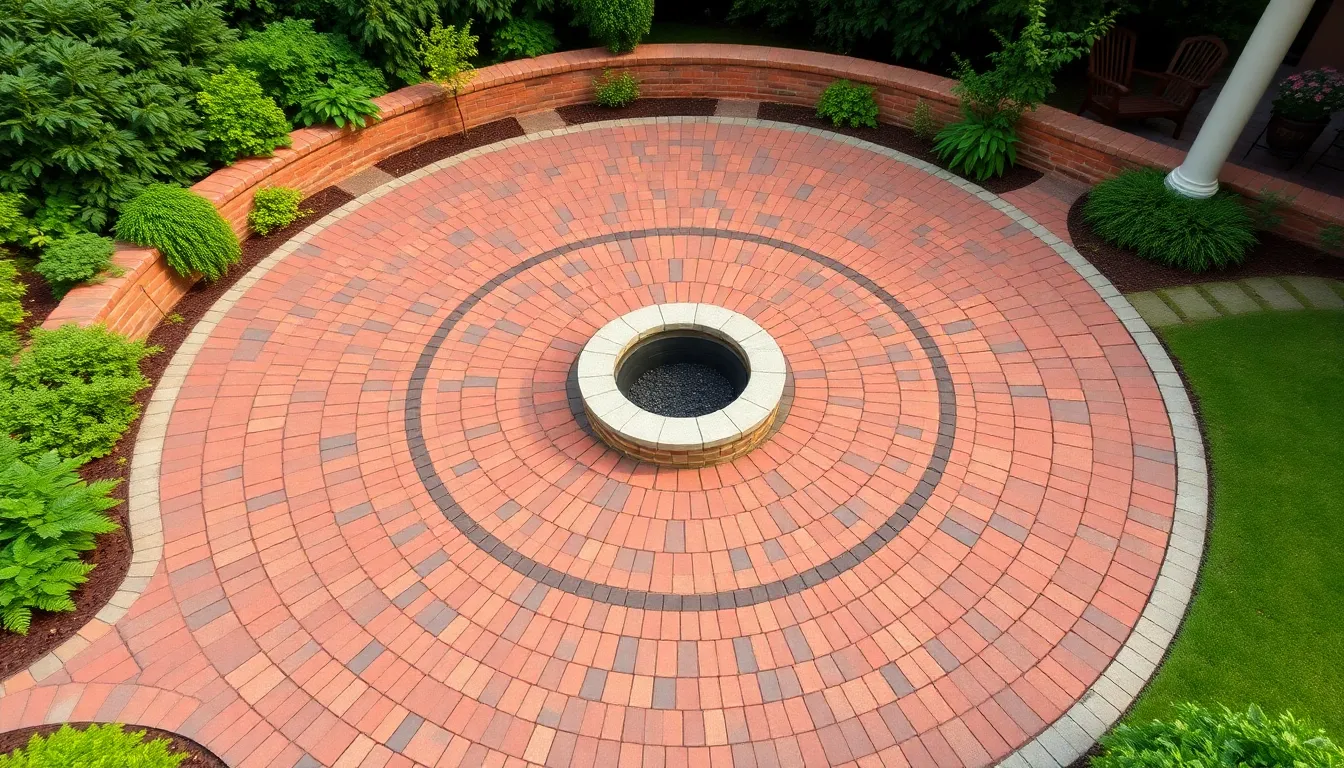
Circular red brick patios break away from angular designs to create intimate gathering spaces that naturally encourage conversation and relaxation. We love how these curved layouts soften harsh yard lines while providing a cozy centerpiece for outdoor entertaining.
Concentric Circle Pattern
Concentric circle patterns arrange brick pavers in multiple rings around a central focal point like a fire pit, water feature, or existing tree. This design creates strong visual rhythm and balance, combining traditional brick texture with elegant geometric form that guides the eye naturally toward the center.
Building these patterns involves laying the innermost circle first, then expanding outward in perfectly aligned rings that maintain consistent spacing. We recommend starting with a 6-foot diameter center circle for intimate seating areas or expanding to 12-foot diameters for larger entertainment spaces. The concentric layout breaks up rectangular yard shapes effectively while providing intuitive pathways and defined seating zones within the overall design.
Multiple rings create depth and architectural interest that works particularly well in garden settings surrounded by lush plantings. Each ring can incorporate slight color variations in the red brick to enhance the pattern’s definition and create subtle visual movement across the patio surface.
Spiral Red Brick Layout
Spiral layouts feature bricks arranged in continuous swirling motions that flow outward from a central starting point, creating ever-changing patterns that captivate viewers and add modern flair to traditional red brick materials. This technique transforms static patio surfaces into flowing designs that invite movement and exploration throughout the outdoor space.
Starting from the center, we lay bricks in gradually expanding curves that maintain consistent spacing while following the spiral’s natural progression. The pattern creates an almost hypnotic effect that draws people into the space and encourages them to follow the brick’s flowing lines with their eyes and footsteps.
These spiraling designs work exceptionally well as pathway elements leading to seating areas or as complete patio surfaces that serve as artistic focal points. We often incorporate spiral patterns within larger rectangular patios to create distinct zones or as transitional elements between different outdoor living areas. The continuous flow of the spiral pattern adds visual interest while maintaining the warm, inviting character that makes red brick patios so appealing for outdoor entertaining.
Red Brick and Stone Combination Patios
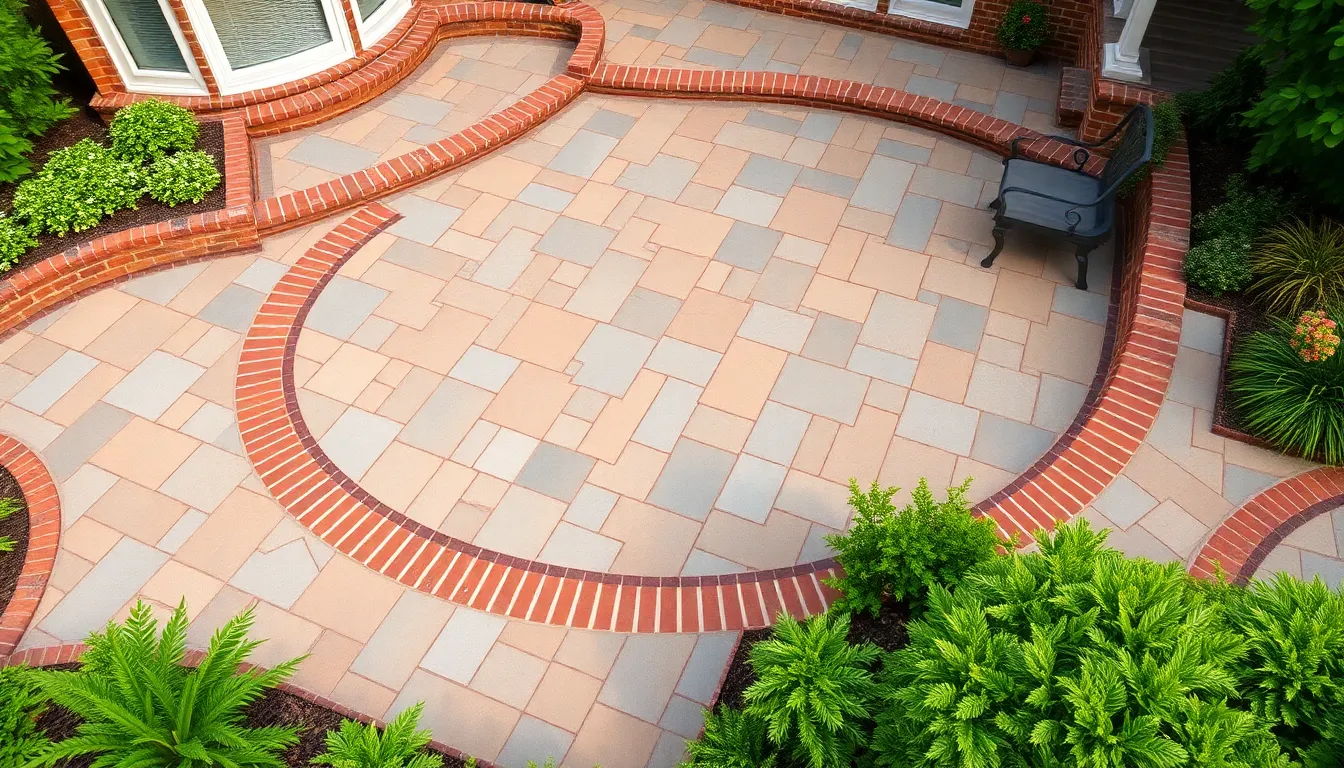
We’ve explored single material patterns, but combining red brick with stone opens up exciting design possibilities that balance warmth with natural elegance.
Brick Edged Stone Center Design
Stone patios with crisp red brick borders create sophisticated outdoor spaces that frame your entertaining area beautifully. We recommend using flagstone or natural stone slabs as the main surface while surrounding them with precisely laid red brick pavers for definition.
Contrasting textures between smooth stone centers and structured brick edges enhance visual appeal while serving practical purposes. The brick edging prevents erosion around your patio’s perimeter and creates smooth transitions between hardscaping and landscaping elements.
Polished appearances emerge naturally when you use this classic technique that stops material shifting over time. We find this combination particularly effective for larger patios where the contrasting materials can showcase their individual beauty while working together harmoniously.
Alternating Brick and Flagstone Pattern
Ever-changing patterns come alive when you intersperse red brick pavers throughout flagstone layouts in repeated geometric arrangements. We create customized designs by alternating these materials in squares, rectangles, or diagonal configurations that add depth and visual texture.
Strategic placement of contrasting materials allows you to zone different areas within larger patios while maintaining design continuity. This technique works exceptionally well when you want to highlight seating areas or create pathways through your outdoor space.
Artistic functionality defines this approach as both materials contribute their unique strengths to the overall design. We often incorporate subtle tile accents or contrasting borders within these alternating patterns to further customize the look and create truly unique outdoor living spaces that blend durability with natural appeal.
Multi-Level Red Brick Patio Designs
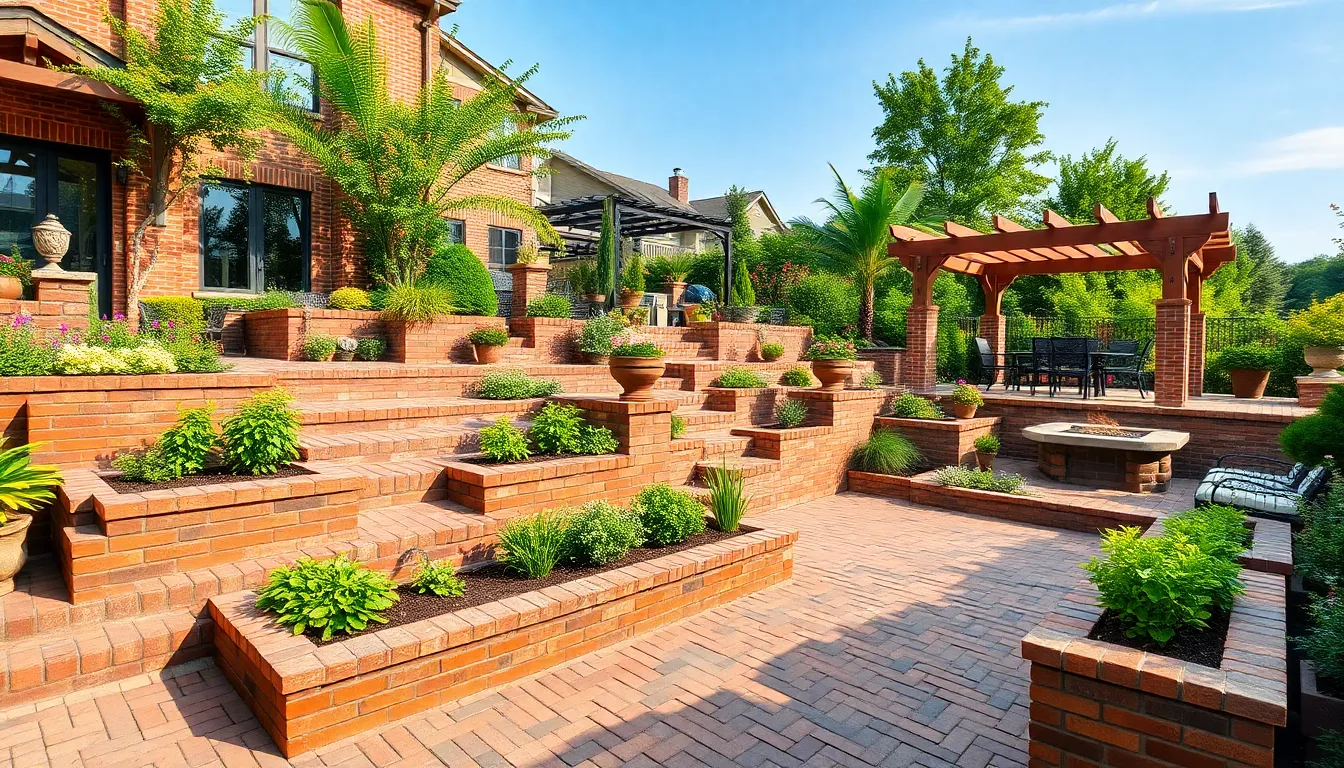
Creating multi-level red brick patios transforms ordinary outdoor spaces into sophisticated entertainment areas with distinct functional zones. These elevated designs work particularly well for sloped yards and provide natural divisions between dining areas, lounging spaces, and garden viewing sections.
Stepped Red Brick Terraces
Building stepped terraces with red brick risers creates gradual elevation changes that make sloped landscapes both functional and beautiful. We recommend using brick steps that connect different levels while maintaining visual continuity throughout the design. Each terrace level can serve as a distinct outdoor room, with upper levels perfect for quiet seating areas and lower sections ideal for dining or entertaining.
Designing these terraced spaces requires careful attention to step height and safety considerations. Professional landscapers suggest keeping step risers between 6 to 8 inches for comfortable navigation while ensuring adequate depth for each terrace level. Adding pebbled ground cover or small planting beds between levels creates natural contrast against the warm red brick surfaces.
Incorporating varying brick patterns like soldier course or basketweave adds texture and visual interest to each terrace level. This approach enables better use of challenging yard slopes while creating multiple outdoor living areas that feel connected yet separate. Fire pits or pergolas can be integrated into exact terrace levels to enhance both function and aesthetic appeal.
Raised Red Brick Planter Integration
Integrating raised brick planters into multi-level patio designs softens hardscape elements while providing lush greenery throughout the space. We find that planters constructed with matching red brick maintain visual cohesion while creating natural borders between different patio levels. These features can serve dual purposes as seating ledges during gatherings or as stunning focal points that draw the eye upward.
Positioning planters strategically around patio levels creates cozy microclimates that enhance outdoor comfort and boost overall curb appeal. Built-in planters work especially well along patio edges or as freestanding elements that define exact areas within larger multi-level designs. The warm tones of red brick complement most plant selections while providing excellent drainage and root protection.
Combining planters with built-in features like pergolas or fire pits creates comprehensive outdoor living systems that feel both functional and inviting. These integrated elements elevate the entire outdoor environment while maintaining the timeless appeal that makes red brick patios such popular choices for sophisticated industry design.
Red Brick Patio Border and Edging Ideas

Creating well-defined borders transforms red brick patios from ordinary surfaces into polished outdoor living spaces. We’ll explore two fundamental edging techniques that enhance both the visual appeal and structural integrity of your patio design.
Soldier Course Brick Borders
Soldier course borders feature bricks laid vertically on their ends with the long narrow side exposed, standing upright in a continuous row around your patio perimeter. This formal border treatment creates clean lines and striking contrast against the field bricks in your main patio surface.
Benefits of soldier course edging include:
- Enhanced definition that frames rectangular or geometric patio layouts
- Elegant emphasis on patio edges that complements various brick patterns
- Visual contrast that showcases the natural color variations in red bricks
- Professional appearance that elevates the overall design sophistication
Installation considerations for soldier course borders require careful attention to brick alignment and consistent height measurements. We recommend using a string line guide to maintain perfectly straight borders while ensuring each brick stands at the same elevation.
Design compatibility makes soldier course borders particularly effective when paired with herringbone or basketweave field patterns. The vertical orientation creates dramatic contrast against horizontal laying patterns while maintaining structural cohesion throughout your patio design.
Header Course Edge Treatments
Header course edging involves bricks laid flat with their shorter ends facing outward to form a solid edge row around your patio perimeter. This robust border treatment provides exceptional durability while creating a finished appearance that locks field bricks securely in place.
Structural advantages of header course borders include:
- Superior edge stability that prevents brick shifting over time
- Enhanced load distribution for patios with heavy foot traffic
- Effective barrier protection against lawn encroachment or garden bed erosion
- Simplified maintenance with reduced need for periodic edge adjustments
Installation benefits make header course treatments ideal for patios adjacent to lawns or garden beds where soil movement might otherwise compromise border integrity. The flat laying position distributes weight evenly while providing a stable foundation for surrounding industry elements.
Versatile applications allow header course edging to complement both traditional and contemporary patio designs. We often combine header course borders with soldier course accents to create sophisticated edge treatments that enhance the natural beauty of red brick installations.
Design flexibility enables creative combinations where header and soldier course treatments work together to frame different sections of larger patio areas. This approach allows for personalized border designs that suit your exact outdoor space requirements while maintaining consistent red brick aesthetic appeal.
Fire Feature Red Brick Patio Layouts

Fire features transform red brick patios into captivating outdoor entertainment spaces that extend living areas beyond the home. Strategic placement of fire elements creates natural gathering points while showcasing the warm character of red brick materials.
Built-In Fire Pit Brick Surrounds
Built-in fire pit surrounds using red brick offer exceptional durability and heat resistance while maintaining design continuity with your patio flooring. We recommend constructing the surround by stacking bricks to form a secure ring or square structure that complements your existing patio pattern.
Circular brick surrounds create intimate gathering spaces by arranging red bricks in concentric rings around the fire pit opening. This design naturally draws people together while the circular pattern flows seamlessly with basketweave or herringbone patio layouts. The curved structure softens angular patio lines and encourages conversation from multiple seating positions.
Square fire pit surrounds provide clean geometric lines that complement running bond or English bond patio patterns. These structures offer more surface area for food preparation or drink placement during outdoor gatherings. The straight edges align perfectly with rectangular patio borders and create defined zones within larger outdoor spaces.
Seating ledge integration enhances fire pit functionality by incorporating low brick walls that double as comfortable seating around the fire feature. These ledges typically measure 18 inches in height and 12 inches in width to provide optimal comfort. The matching brick construction creates visual unity while eliminating the need for additional outdoor furniture around the fire area.
Contrasting mortar accents add visual interest to brick fire pit surrounds through color variations that highlight the bricklaying pattern. Light colored mortar creates bold contrast against red bricks while dark mortar provides subtle definition. Decorative pointing techniques such as weathered or raked joints add texture and traditional character to the fire pit surround.
Outdoor Fireplace Brick Integration
Outdoor fireplaces built with red brick seamlessly blend with patio surfaces to create cohesive entertainment areas that serve as striking focal points. We suggest using the same brick style and color as your patio flooring to unify the entire outdoor space visually.
Freestanding brick fireplaces anchor patio designs while providing warmth and ambiance from multiple viewing angles. These structures work particularly well with circular or semi-circular brick patio patterns that complement the fireplace’s commanding presence. The freestanding design allows for flexible furniture arrangement and creates natural traffic flow around the fire feature.
Wall-mounted fireplace integration maximizes patio space while creating impressive vertical elements that define outdoor rooms. These installations work best when the supporting wall uses matching red brick construction or complementary materials like natural stone. The wall-mounted approach leaves more floor space for seating arrangements and dining areas.
Brick hearth construction creates safe and attractive zones around outdoor fireplaces using paved brick surfaces that extend beyond the firebox opening. These hearths typically extend 12 inches on each side and 16 inches in front of the fireplace opening for safety compliance. The brick hearth pattern can match or contrast with the main patio design to create visual interest and define the fireplace area.
Complementary outdoor furniture placement completes fireplace areas with weather-resistant seating options like wrought iron or wicker pieces accented with cushions and outdoor rugs. The furniture arrangement should allow for comfortable conversation while maintaining safe distances from the fire feature. Strategic placement creates intimate seating zones that take advantage of the fireplace’s warmth and visual appeal.
Enhanced feature integration combines outdoor fireplaces with additional elements like raised garden beds filled with heat-tolerant plants or pergolas that provide overhead structure. These complementary features balance the hardscape elements with softscape materials while creating comprehensive outdoor living systems. The combined elements work together to establish comfortable microclimates that extend the outdoor season and enhance entertainment possibilities.
Small Space Red Brick Patio Solutions
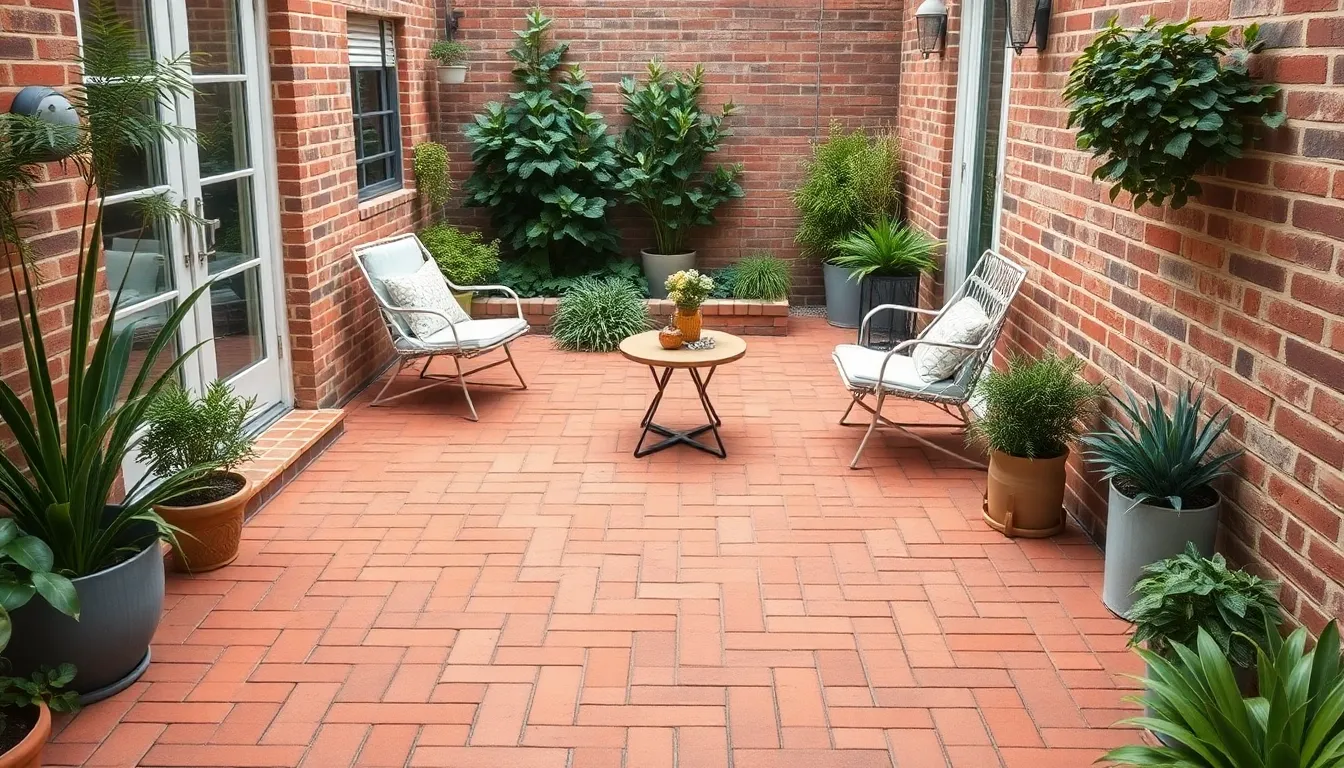
Working with limited outdoor space requires strategic design choices that maximize both functionality and visual appeal. We’ll explore how red brick layouts can transform even the smallest areas into inviting outdoor retreats.
Compact Square Brick Layouts
Square brick patterns excel at making small patios feel more spacious through their clean, organized appearance. We recommend starting with simple square layouts that create visual expansion when paired with minimalistic landscaping and clean lines.
Basketweave configurations combined with soldier course borders add architectural interest without overwhelming compact areas. This intricate pattern arrangement provides texture and depth while maintaining the organized feel essential for small spaces.
Herringbone designs bring warmth and ever-changing energy to square patios through their classic zigzag formation. We’ve found this pattern particularly effective for both modern and rustic décor styles, creating refined focal points in limited areas.
Pattern Benefits for Compact Spaces:
| Pattern Type | Visual Effect | Installation Ease | Best For |
|---|---|---|---|
| Simple Square | Expands space visually | Easy | Minimalist designs |
| Basketweave | Adds texture | Moderate | Traditional styles |
| Herringbone | Creates movement | Moderate | Ever-changing layouts |
Narrow Side Yard Brick Designs
Linear brick arrangements work exceptionally well for elongating narrow side yards through running bond patterns. We position bricks in continuous lines that draw the eye along the length of the space, creating inviting walkways or intimate seating nooks.
Integrated greenery transforms narrow brick paths into lush outdoor corridors by incorporating house hugging plants and small trees. These natural elements create an enclosed, garden like feeling even though the limited width of side yard spaces.
Functional seating answers maximize utility in narrow areas through slim outdoor furniture positioned alongside brick surfaces. We select narrow benches and streamlined pieces that maintain openness while adding comfort and practical use to these challenging spaces.
Vertical space utilization becomes crucial in narrow designs, where hanging planters or hooks between wooden elements add personality without consuming precious floor area. This approach works particularly well for herb gardens or decorative glass containers suspended above the brick surface.
Multi functional zoning creates distinct areas within narrow spaces using brick layout changes and natural borders. We separate different uses through potted flowers or subtle pattern transitions, maximizing the functionality of every square foot available.
Red Brick Patio Maintenance and Sealing Tips
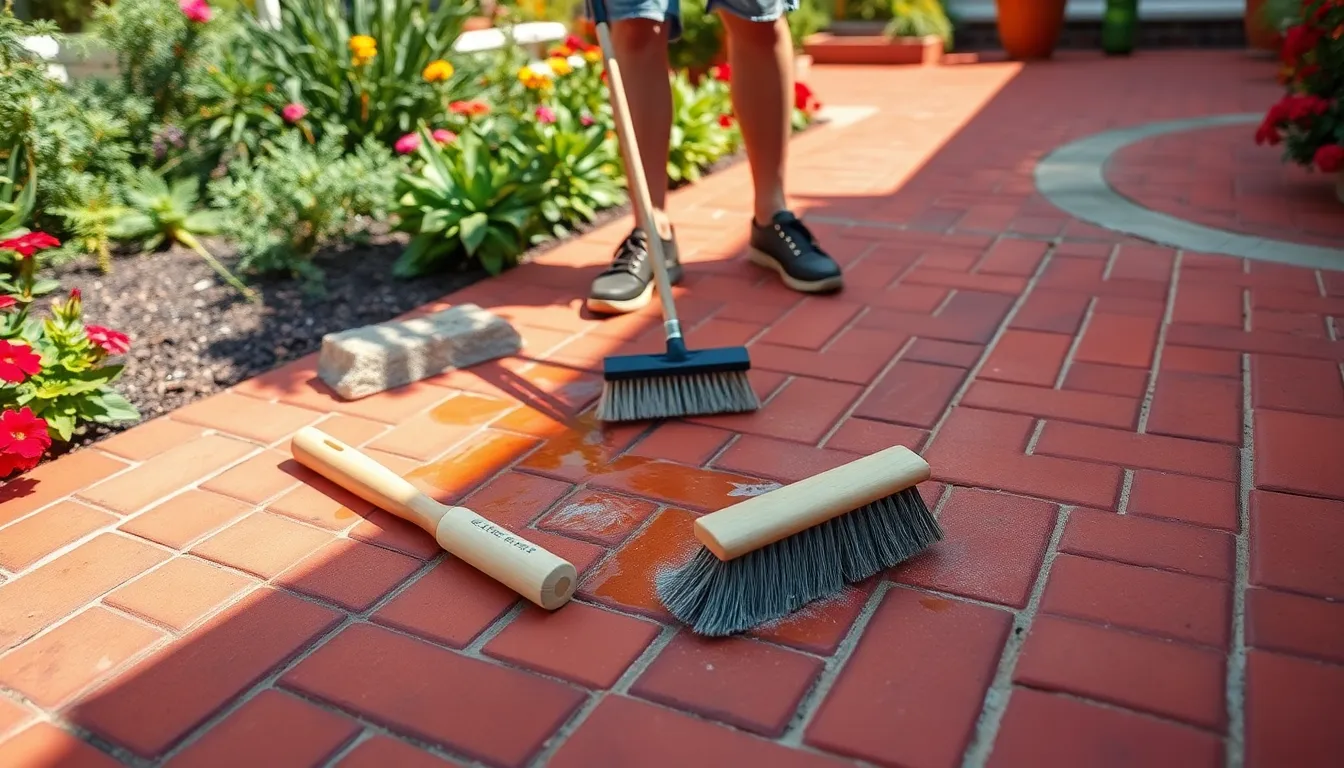
Proper maintenance transforms your red brick patio into a long-lasting outdoor investment that retains its beauty and functionality for years. Regular sealing with high-quality brick sealant enhances color vibrancy while preventing moisture penetration and reducing moss growth.
Cleaning Red Brick Surfaces
Regular debris removal keeps your patio looking pristine and prevents staining that can permanently damage brick surfaces. We recommend using a broom or leaf blower weekly to eliminate leaves, dirt, and organic matter before they settle into mortar joints.
Stain treatment requires gentle yet effective cleaning methods to preserve brick integrity. Mix water with mild detergent or vinegar to create a natural cleaning solution that safely removes moss, algae, and surface stains without harsh chemicals.
Pressure washing can effectively clean large patio areas when done correctly with low pressure settings. We suggest testing a small, inconspicuous area first to ensure the mortar joints won’t be damaged by the water pressure.
Scrubbing techniques work best for stubborn stains and moss buildup that standard cleaning can’t remove. Use a stiff brush with your cleaning solution to gently work away accumulated grime while protecting the brick surface from scratches.
Weather Protection Methods
Sealant application creates a waterproof barrier that protects against rain and freeze-thaw cycles that cause cracking and mortar deterioration. We recommend reapplying high-quality brick sealants every few years depending on your local weather exposure conditions.
Drainage management prevents standing water that can seep into brick pores and cause structural damage over time. Install proper drainage systems around your patio perimeter and maintain existing drainage channels clear of debris.
Winter protection involves using covers or tarps during harsh weather months when possible to shield your patio from extreme temperature fluctuations. This extra step significantly extends the lifespan of both bricks and mortar joints.
Regular inspections allow you to identify mortar joint deterioration early and schedule timely tuckpointing repairs. We suggest checking your patio twice yearly for loose mortar, cracked bricks, or drainage issues that need immediate attention.
Conclusion
We’ve explored countless possibilities for transforming your outdoor space with stunning red brick patio designs. From timeless herringbone patterns to innovative spiral layouts these versatile materials offer endless creative potential for any backyard.
Whether you’re working with a compact courtyard or expansive garden area red brick patios deliver both beauty and functionality. The combination options with natural stone fire features and multi-level designs prove that red brick adapts beautifully to any style preference.
Remember that proper maintenance and sealing will keep your red brick patio looking vibrant for decades to come. With these design ideas and practical tips you’re ready to create an outdoor living space that’ll become the heart of your home’s entertainment area.
Frequently Asked Questions
What are the most popular red brick patio patterns?
The most popular red brick patio patterns include herringbone (both 45-degree and 90-degree), running bond, basket weave, and circular designs. Herringbone patterns offer elegance and structural stability, while running bond creates a timeless foundation. Basket weave adds striking texture, and circular patterns create intimate gathering spaces perfect for conversation areas.
How do I choose between herringbone and running bond patterns?
Choose herringbone for high-traffic areas requiring maximum stability and visual interest, as it showcases natural brick color variations beautifully. Select running bond for a straightforward, timeless approach that works well in both traditional and modern settings. Running bond is easier to install and particularly effective for elongating narrow spaces.
Can I combine red brick with other materials in my patio?
Yes, red brick pairs beautifully with natural stone, flagstone, and concrete. Popular combinations include brick-edged stone centers, alternating brick and flagstone patterns, and brick borders around different materials. These combinations balance warmth with natural elegance while allowing you to zone different areas within larger patios.
What’s the best red brick patio design for small spaces?
For small spaces, use compact square layouts with basketweave patterns or herringbone designs to add visual movement. Consider soldier course borders for architectural interest, and utilize vertical space with planters. Linear arrangements work well for narrow side yards, while multi-functional zoning maximizes utility in limited areas.
How often should I seal my red brick patio?
Seal your red brick patio every 2-3 years with high-quality brick sealant to enhance color vibrancy and prevent moisture damage. However, frequency depends on climate conditions and usage. Regular inspections will help determine when resealing is needed, especially if you notice fading colors or increased water absorption.
Are multi-level red brick patios suitable for sloped yards?
Yes, multi-level red brick patios are excellent for sloped landscapes. Stepped terraces create functional elevation changes while maintaining beauty. Consider varying brick patterns for added texture, integrate raised planters for softening, and ensure proper drainage. Professional installation is recommended for complex slope management and safety considerations.
What maintenance does a red brick patio require?
Regular maintenance includes debris removal, gentle cleaning with natural solutions, and careful pressure washing when needed. Inspect mortar joints annually for deterioration and repair promptly. Manage drainage to prevent water damage, use winter covers in harsh climates, and reseal periodically to maintain appearance and durability.
Can I install a fire feature with my red brick patio?
Absolutely! Red brick fire features create stunning focal points and extend outdoor entertaining seasons. Consider built-in fire pit surrounds or integrated outdoor fireplaces using matching brick styles. Include seating ledges and ensure proper safety clearances. Professional installation is recommended for gas connections and local code compliance.

